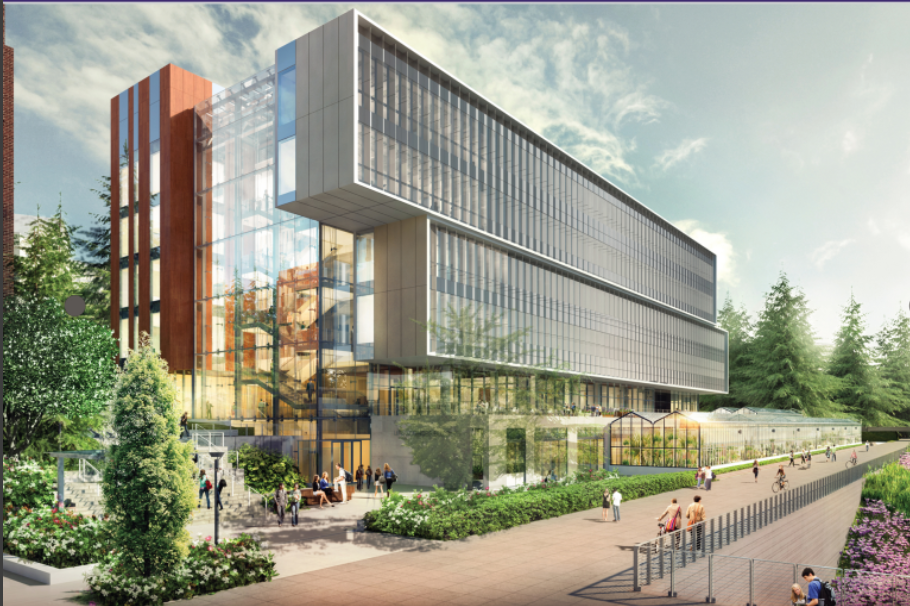INTRODUCTION
UW-Solar is working with the University of Washington (UW) and project architects, Perkins+Will, on the construction of UW’s Life Sciences Building. The purpose of this letter is to request $150,000 for the installation of roof-top photovoltaic (PV) panels and building-integrated photovoltaics (BIPV) on the new Life Sciences Building.
SUMMARY
UW-SOLAR SUMMARY
UW-Solar is an interdisciplinary team within the University of Washington’s Urban Infrastructure Laboratory that focuses on the development of solar installations with accompanying Industrial Control Systems on buildings on the UW campus. UW-Solar students range from undergraduate to the Ph.D. level within the Colleges of Engineering, Business, Built Environments, and Environmental Sciences. UW-Solar’s primary objective is to provide clean, sustainable power production to reduce the University of Washington’s reliance on external energy resources, improve power systems’ resilience to outages, and reduce the overall carbon footprint of the university. The usage of clean and renewable energy sources are a primary objective of the University of Washington’s Climate Action plan for the future sustainability of the University.
PROJECT SUMMARY
UW is working with Perkins+Will to construct the new Life Science Building. The implementation of a roof-top PV array will enhance the energy generation of the existing design, bringing the project closer to achieving LEED-NC Platinum certification. The identified potential for solar power generation on the new construction includes standard PV panels on the roof and BIPV on glass fins located on the southeast façade.
The BIPV addition is fully designed and slated for construction; however, the roof-top PV addition would be coordinated upon completion of building (scheduled for August 2018). This funding request is for the installation of both PV and BIPV systems. The proposal to CSF will include the complete installation and budget details for both systems.
ENVIRONMENTAL IMPACT
The addition of photovoltaics to the Life Sciences Building will have a positive impact on the environment through the on-site production of renewable energy, which will both reduce the carbon-footprint of the building and increase its energy self-sufficiency.
The 120 BIPV fins on the southwest facade of the building provide up to 6,000 ft2 of south-east facing surface area for energy generation. Harnessing the potential energy output of this area could provide a significant source of renewable energy.
There is approximately 18,000 ft2 of available space for a PV installment on the roof penthouse, and an additional 2,300 ft2 of space on level 05. We propose a combined 100 kW PV system be installed on these surfaces.
STUDENT LEADERSHIP & INVOLVEMENT
UW-Solar completed a feasibility study for this project and presented installation options and recommendations to Perkins+Will for implementation. This project has and will continue to allow students to work with industry experts and gain experience working on project development, design, and construction management in a professional setting.
EDUCATION, OUTREACH, AND BEHAVIOR CHANGE
Research on the BIPV installation will directly affect future installations of BIPV around the state, as the University would be one of the first public institutions to implement this relatively new technology. A proposed Lucid dashboard in the lobby of the Life Sciences Building will show energy generated from both the BIPV and PV systems along with the energy use of the building. Visitors will be able to interact with the display to explore the building’s energy metrics and sustainable design features. The integrated PV panels on the southwest façade will be highly visible from Pacific Avenue. The unique aspects of this project make the new Life Sciences Building a leading example of sustainability in higher education and demonstrate the University’s commitment to investing in alternative energy sources.
ACCOUNTABILITY
The feasibility study investigated ongoing accountability for management and maintenance of the solar installations, as well as long-term leadership considerations for the project as it relates to executive stakeholders, logistical management, and staffing and budget impacts of relevant stakeholder organizations.
ESTIMATED BUDGET
|
BIPV Installation
|
$300,000
|
|
Roof-top Installation
|
$300,000
|
|
Total
|
$600,000
|
We are exploring multiple funding opportunities to secure the full $600,000 needed for both installations. We are requesting $150,000 in funding from CSF, which will be instrumental in securing the additional $450,000 from matching grant programs such as the Department of Commerce Solar Grants, which awards funding equal to the initial seed money already secured.
In the event we are unable to acquire the full $600,000, the $150,000 awarded will be returned to CSF.
CONTACT INFORMATION
Life Sciences Building Project Managers:
Project Manager - Alex Ratcliff, alexr529@uw.edu
Team Lead - Ian Rose, isr2@uw.edu
Facility Manager - Jan Whittington, janwhit@uw.edu
Urban Infrastructure Lab Manager - Stefanie Young, sy10@uw.edu
